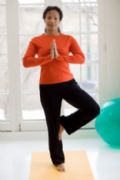|
What is with all the weird looking toys you see in gyms, sporting goods stores As it turns out, each of these fitness tools is specially designed to help people improve their balance. You may think that the elderly are the only ones who should be concerned about balance, but that couldn't be further from the truth. Think back with me to when you were a kid. Do you remember some of the things we used to challenge each other to do? Things like "how long can you hop on one foot?" or "who can walk on the edge of the sidewalk the longest without falling off?" We didn't call it exercise or balance training then, but that is exactly what we were doing. Activities like these helped us to develop our balance and stability and to survive our youthful clumsiness. Today, the world's top athletes recognize that balance training helps them to perform better in their sports, and fitness experts know that good balance and a strong core go hand-in-hand. You don't have to be a world-class athlete to add a little balance training to your workouts, though. Plenty of simple exercises you can do at home or at the gym will improve your balance significantly. But if sticking a dismount or avoiding a tackle aren't on your list of daily priorities, why does balance training matter? Let’s look at the reasons why balance training is so important. Benefits of Balance TrainingLet me spring a big word on you here: When the information received is too complex to translate, the system gets overwhelmed and you lose your balance. But with practice and experience (i.e. By training to develop greater balance, you will recognize improvements in coordination, athletic skill and posture. This in turn will result in fewer injuries and greater stability as you age, which can help prevent falls and keep you both strong and independent longer. These are the very benefits that have led many coaches, trainers and athletes to incorporate balance training into their workouts. Where Should I Start?Here is a good test to evaluate your own balance: Stand up and imagine you're going to walk forward in a straight line, placing one foot directly in front of the other so that the heel of your front foot touches the toes of your back foot. Keep both feet flat on the floor. Hold that position and close your eyes. If you can maintain your balance for 30 seconds, you are doing pretty well. If you are wobbling just about as soon as you close your eyes—or before—your balance is poor. If you did not perform as well as you thought you should, it's okay. You don’t need to buy expensive equipment to improve your balance. You can do several exercises without any equipment. By searching online or speaking with a personal trainer, you can find exercises that promote balance. Try adding five or 10 minutes of balance exercises to your workouts three times a week. How can you tell if you are getting better? When you can maintain your balance during the various exercises (or the balance-training test above) for longer periods of time. If you want to do some serious balance training (a good idea after you've mastered some of the basic exercises), you can choose from a variety of balance-training toys to help you reach your goals. If you have a gym membership, your gym may carry some or all of these types of equipment. While some are pricier than others are, keep in mind that balance-training equipment isn't necessary for improving your balance—it just helps you take it to the next level. These are three of the more common types of balance equipment that you might see in gyms or in stores:
Balance training is good for people of every age, so get the family involved. Everyone from your preschooler to grandparents can benefit and, because it is so fun, they may not even recognize they are exercising! The best news is that you can start right now—and see improvements quickly! |








